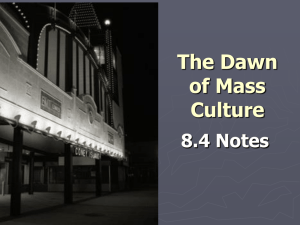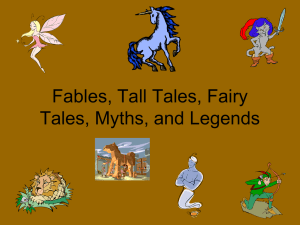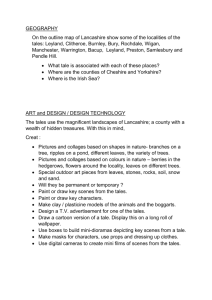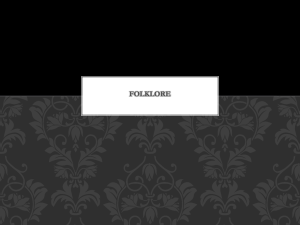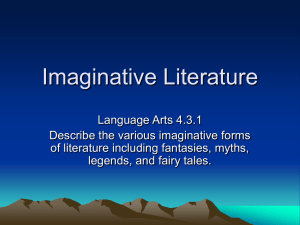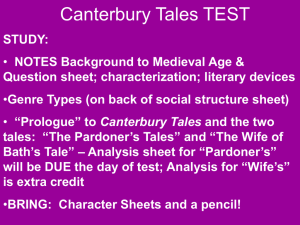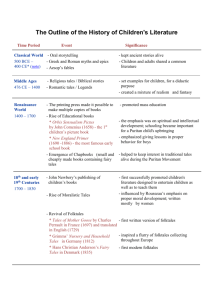A Brief History of Children`s Literature CONCEPTS TO REMEMBER
advertisement
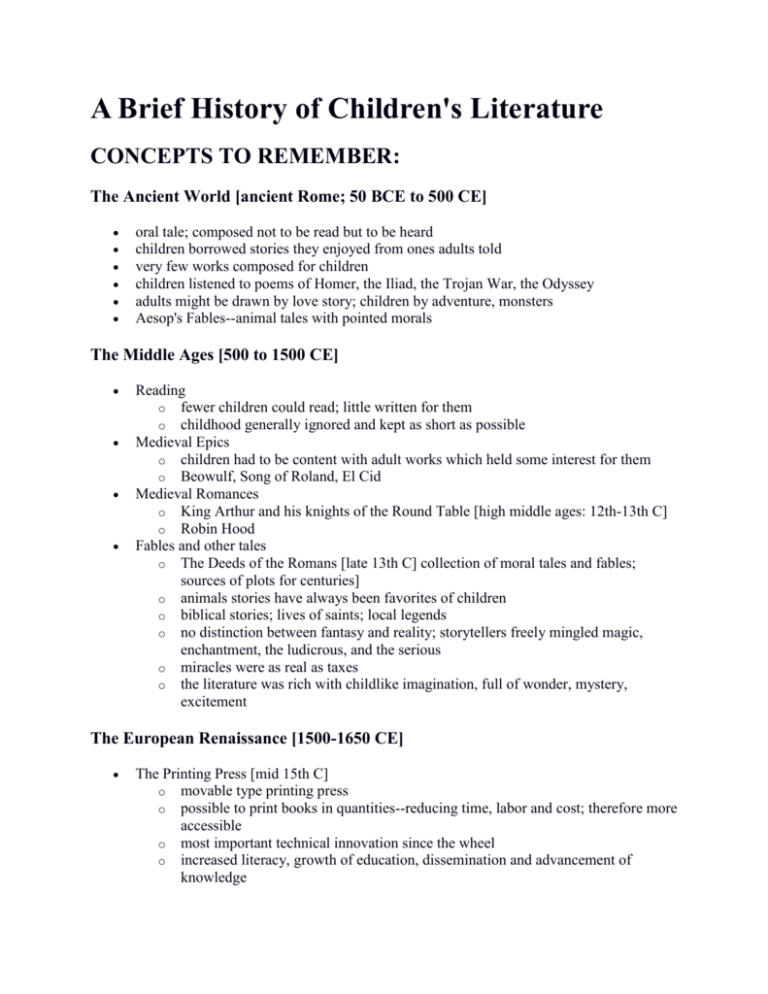
A Brief History of Children's Literature CONCEPTS TO REMEMBER: The Ancient World [ancient Rome; 50 BCE to 500 CE] oral tale; composed not to be read but to be heard children borrowed stories they enjoyed from ones adults told very few works composed for children children listened to poems of Homer, the Iliad, the Trojan War, the Odyssey adults might be drawn by love story; children by adventure, monsters Aesop's Fables--animal tales with pointed morals The Middle Ages [500 to 1500 CE] Reading o fewer children could read; little written for them o childhood generally ignored and kept as short as possible Medieval Epics o children had to be content with adult works which held some interest for them o Beowulf, Song of Roland, El Cid Medieval Romances o King Arthur and his knights of the Round Table [high middle ages: 12th-13th C] o Robin Hood Fables and other tales o The Deeds of the Romans [late 13th C] collection of moral tales and fables; sources of plots for centuries] o animals stories have always been favorites of children o biblical stories; lives of saints; local legends o no distinction between fantasy and reality; storytellers freely mingled magic, enchantment, the ludicrous, and the serious o miracles were as real as taxes o the literature was rich with childlike imagination, full of wonder, mystery, excitement The European Renaissance [1500-1650 CE] The Printing Press [mid 15th C] o movable type printing press o possible to print books in quantities--reducing time, labor and cost; therefore more accessible o most important technical innovation since the wheel o increased literacy, growth of education, dissemination and advancement of knowledge Social Changes o Crusades of 11th-12th C opened trade routes to the East as far as India o strong central monarchies harnessed warring feudal lords--encouraged peaceful commerce and industry o European arrival in the Western Hemisphere ("New World") and wealth and opportunity o created a new middle class of merchants which valued education Instructional Books o children more literate o reading materials were instructional books (Books of Courtesy) and works written primarily for adults o still had Aesop's Fables o Book of Martyrs (1563), anti-Catholic work of horrific scenes of violent death for the sake of religion, most popular reading material for children o Earliest children's illustrated book--Latin through pictures (Orbis Sensualium Pictus)--1658, a Latin vocabulary book o by end of the 17th century social changes were well underway and there was a path cleared for a genuine literature for children. The 17th Century childhood began to take on new importance adults began to recognize the special needs of childhood, including the need for childhood reading two specific influences brought a heightened sense of special needs of the child o Religious: rise of Puritanism, that placed special emphasis on the individual's need to tend to his or her own salvation o Intellectual: work of John Locke, the English philosopher The Puritans o knowledge of the Bible was necessary for every human being o consequently, the ability to read and to understand the Bible was a principal requirement for Puritan children o in 1636 established a college--Harvard--to emphasize their commitment to the primacy of education o Bible stories were the staple of Puritan children o horn books contained rudimentary language lessons (alphabet, numerals, etc.) o The New Primer--first appearing 1685-90 and continuing in print until 1886. A Puritan publication introducing young children to the alphabet through rhymes (A: In Adam's fall/We Sinned all) John Locke o 1693 wrote a famous essay Thoughts Concerning Education, in which he formulated his notion that the minds of young children were similar to blank slates (tabula rasa) just waiting to be written upon and this instructed. o believed every child possessed the capacity for leaning and that it was the responsibility of adults to see to the proper education of children Bunyan, Defoe, Swift o children continued to adopt certain adult works of literature--Pilgrim's Progress, Robinson Crusoe, Gulliver's Travels The 18th and Early 19th Centuries John Newbery o Little Pretty Pocket Book (1744) first significant publication for children o sought their edification and also their enjoyment o a collection of songs, moral tales, crude woodblock illustrations Rousseau and the Moral Tale o expressed his ideas about education in Emile (1762), emphasized the importance of moral development--through simple living o books taught children how to be good and proper human beings o children¹s writing was considered inferior to adult writing and therefore mostly composed by women Rise of the Folktales vthrough the early 19th century there was little to distinguish children's literature o o o o o o 1729--Tales of Mother Goose by Charles Parrault, retellings including Cinderella, Little Red Riding Hood, Sleeping Beauty throughout the eighteenth century, more and more retellings appeared beginning of 19th century--Grimm brothers folktales were not considered expressly for children some adults felt them unsuitable for children as they contained adult themes, alarming frankness and violence, lack of moral messages children, nevertheless, continued to read and love the old tales The Victorians: The Golden Age during the reign of Queen Victoria (1837-1901) children's literature first blossomed influenced by the Romantic Movement which idealized childhood and lead to a greater interest in children first-rate authors and illustrators began to turn their talents to children and their books Fantasies o 1865, Lewis Carroll (Charles Dodgson--math prof at Oxford) published Alice's Adventures in Wonderland and began a new era in children¹s literature o first significant publication for children that abandoned all pretense of instruction and was offered purely for enjoyment o Kingsley's The Water Babies (1863); MacDonald's The Princess and the Goblin (1872); Baum's The Wizard of Oz (1900); Grahame's The Wind in the Willows (1908). Adventure Stories (for boys) o especially popular Stevenson's Treasure Island (1883); Twain's The Adventures of Tom Sawyer (1976) and The Adventures of Huckleberry Finn (1884) o British children seemed to prefer stories set in faraway and unfamiliar places; Americans more attracted to adventure stories set in America and rags-to-riches stories o Dime Novels--sensational, lacking style and depth, cheap--were immensely popular School Stories (for boys) o antics of boys at boarding schools: Tom Brown's School Days (1857) o school stories (virtually always coming-of-age tales) occasionally appear in the 20th century, such as The Chocolate War Domestic Stories (for girls) o tales of home and family life focusing on the activities of a virtuous heroine, usually coming from dire straits and achieving good fortune and ultimate happiness in the person of a handsome young man o Alcott's Little Women (1868) and Montgomery's Anne of Green Gables (1908) Children's Book Illustration o books of 18th century and earlier either lacked illustrations altogether or contained crude woodblock illustration--serious artists did not draw for children's books o At the end of the 19th century, changes in publishing and printing attracted great illustrators o by end of the 19th century, stunningly illustrated children's books were available at reasonable prices o by 1st quarter of 20th century, libraries were designating children's rooms--or at least children¹s shelves--children's literature had at last come of age. Twentieth Century: Widening Worlds greater diversity in children's books picture books to poetry to fantasy to realistic fiction to informational books greater appreciation for quality numerous book award established o Newbery Medal, most distinguished American book written for children in a given year o Caldecott Medal for the most distinguished American contribution to children's book illustration References: http://www.southernct.edu/~brownm/300hlit.html


